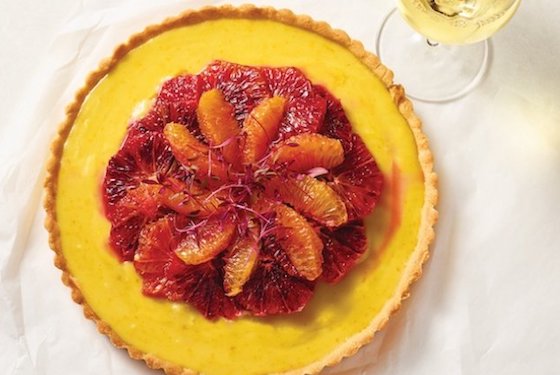When Ryan Bailey made the trek from the NoMad New York to Los Angeles to head up the wine program at the restaurant’s new location in early 2018, he found a new arsenal of ingredients to consider.
“I’d never heard of pink blueberries in my life!” laughs Bailey, who grew up in California and started his career in Sonoma County restaurants but was still blown away by the farmers markets and seasonal produce when he returned to the West Coast. “Like the fact that we’re going into October and the berries and tomatoes are amazing,” he says.

By Liz Grossman, managing editor of HOTELS sister publication Plate
The bounty of local produce fuels the creativity in the kitchen, especially the pastry team, led in Los Angeles by Henry Molina. “We run just a handful of desserts and they’re changing all the time based upon what’s available to our chefs,” says Bailey.
His pairing options are equally inspired by the ever-changing, 1,800-plus wine list with more than 50 by-the-glass offerings, including more than 10 dessert wines. “Right now we have an amazing 1994 Coteaux du Layon, a 1969 Madeira, and a Clairette de Die, which is a super-versatile sparkling dessert wine from the Rhône Valley,” says Bailey, who also likes to pair desserts with sherry (from bone-dry manzanilla to textured oloroso).
He’s also a big fan of dessert wine varietals made from Loire Valley grapes, which are typically higher in acid due to the region’s cooler climate.
“When you’re talking about dessert wines, you have higher residual sugar or sweetness in the wine, which gives it a syrupy or naturally textured element,” Bailey notes. “If you have a grape varietal that’s low in acid, it kind of tastes like cough syrup or a purée. But a dessert wine made from a grape varietal that’s high in acid has balance. It has richness and sweetness, but the acid cleanses your palate so you’re not sipping on syrup. To me, those low-acid dessert wines are dessert in themselves. If I want a glass of port or Pedro Ximénez, I sip it on its own and skip dessert,” he says.
Not to say that traditionally sweet, lower-acid dessert wines can’t still work with desserts. Bailey loves muscat du Cap Corse from Corsica for what he calls its pristine hints of guava blossoms.
“And the alcohol isn’t exceptionally high, so you’re not going to fall out of your seat, but at the same time it adds a bit more texture and weight,” he adds, having served it with the restaurant’s milk and honey dessert, a combo of honey brittle, oat shortbread, milk ice cream, and dehydrated milk foam.
The dessert was tweaked slightly for the L.A. menu, and he pairs it with that Coteaux du Layon, a late-harvest chenin blanc. “I love this pairing because the wine and dessert share this beautiful, high-tone honey note and toasted graham cracker essence,” Bailey says. “And the texture of the wine isn’t cloying, so it doesn’t overpower the dish.”
Citrus forward
While an oat, milk, and shortbread dessert presents more of a neutral canvas for pairing, citrus can add complexity. At The Salty Tart in Minneapolis, Michelle Gayer makes a blood orange tart she prefers to pair with a crisp, bright brut rosé.
“I’d never pair a sweet wine with dessert,” she says. “Sugar on sugar kills your palate, and my food philosophy has always been to leave them coming back for more.
“Bright, clean things go with dessert,” she continues, as she talks about how much she likes how the dry and bubbly brut cuts through the orange flower water-kissed pastry cream and buttery tart shell, while still allowing the blood orange segments on top to shine. “There has to be that balance between sweet and not drinking something sweet with it.”
For this pairing, Bailey suggests a wine that doesn’t just cut through the richness of the tart but complements the entire dessert, like a vin doux naturel (a fortified dessert wine) from northern Corsica.
“Antoine Arena has one small parcel of muscat blanc à petits grains that’s fortified with Corsican grappa,” he says. “This additional alcohol gives it a touch of weight and body while not overpowering the gorgeous floral aromatics. On the palate, the wine is all about candied citrus blossom, ginger spice, and pineapple daiquiri—a perfect complement to a blood orange tart.”
While rot is generally a bad thing, grapes that are infected with botrytis, or noble rot, are prized in the dessert wine world. The sugar-concentrating fungus that affects grapes in humid regions (and near lakes or rivers) doesn’t destroy the crop, but enhances and changes the flavor profile of the grape to express notes of honey, oxidized lemon, citrus, and even gingersnap that lend well to dessert pairing.
Dessert wines like Hungarian Tokaji aszú, Sauternes, and German rieslings made in the fashion of beerenauslese or trockenbeerenauslese are harvested when affected by noble rot, as well as the Coteaux du Layon, a sweet white wine from the Loire Valley.
“You have a little bit of depth and complexity given off by the botrytis, which kind of lends itself to working with things that pastry chefs might be experimenting with for dessert, like herbs or something a little more savory,” says Bailey. “It’s also an exceptional pairing for a cheese course.”
Find this story and others at Plateonline.com
